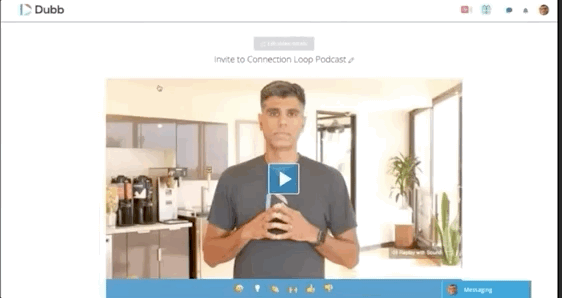NFTs…Augmented/Virtual Reality…Metaverse…these are proof that the internet is evolving very very quickly.
But one thing is certain — video communication is still at it’s prime and not going anywhere.
If anything, it’s only increasing and spreading faster.
From video conferencing and webinar panels… to show-and-share social videos, video is everywhere (and smart businesses are making the most of them).
Right now, creating and sharing video content is one the most efficient ways to grab and hold attention.
But creating these videos aren’t exactly a walk in the park…at least not for everyone. It’s not easy to feel comfortable on camera, so if this is something you struggle with, you should know that you are not alone.
Like I always say:
“One of the reasons why I like video so much is because sometimes I’m lazy. When I want to send a message, it is so much easier for me to grab my phone, put it into selfie mode, record a quick video and send it out to someone”
Everyone you see making videos and having you think…
“oh! They’re so good at this”
…have all been through that stage where they struggled to get in front of and feel comfortable on camera.
With getting comfortable on camera, all it comes down to one thing. Practice.
It’s about showing up for yourself every day. And maybe hitting the record button on that first video about 200 times…until you get something that you’re comfortable with.

It gets easier from there.
As we use video more across our professional and personal lives, being on camera is increasingly something that everyone should know how to do… so we can all harness the power of video.
WHY YOU SHOULD OVERCOME YOUR FEAR OF BEING IN FRONT OF THE CAMERA
I could write 500 paragraphs on why you should feel comfortable on camera.
But if you’re wondering why you should bother to push yourself in front of the camera…here’s a quick reminder.
Video has been tried and tested. Marketers love and use video because it works…and there’s data to back it up.
- 86% of businesses are now using video as a marketing tool
- 92% of marketers consider video as an important part of their marketing strategy
- 87% of marketers say video gives them a good ROI
As you can see, more and more businesses are using videos, but why?
Why Should You Use Videos?
-
They’re a huge time saver
Recording a video is much more efficient than writing text.
Because let’s be honest, writing a text-based email can take a lot of time, compared to recording a video.
With video, you can record a 30-60 seconds video, and still get your point across – in a more conversational manner.
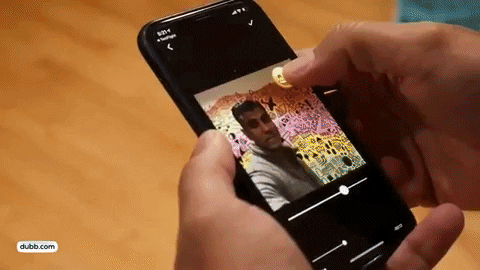
Plus, it reduces the tendency of words to be misunderstood in translation. From your gestures, facial expressions, and the tone of your voice, the viewer is able to know exactly what you mean with every word.
-
Helps build connections faster
It is a lot easier to create a para-social connection/relationship with video than with text.
People feel delighted by a human connection… and video creates that human connection easily and faster than text only.
-
Improve Communication
Statistics show that;
- visuals (i.e. pictures and videos) are processed 60,000 times faster in the brain than text,
- 37% of people respond better to visual information than plain text.
Hence, the chances for your viewer to understand and also remember your message quicker are higher… if the message is passed visually (i.e. video).
-
Stand out from the crowd
In the sea of text-based emails, your video emails stand a higher chance to shine through and be different.
With our attention span reducing, the chances of capturing your viewer’s attention are much higher with videos… as opposed to text.
-
Higher response rate
The most problem sales team/marketers face is the ability to get the first and initial response.
With video, you’re able to personalize your outreach in powerful ways… and put a face to what could otherwise feel like a generic cold outreach or sales process using text.
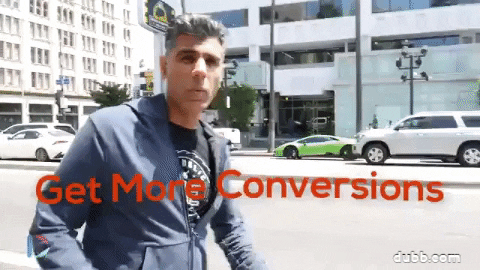
Video allows you to find creative ways to share your messaging… in order for you to break through the noise, stand out, and receive a response.
-
Video builds trust
Trust is a key component in every brand’s relationship with its audience.
It is the one element that factors into nearly every purchasing decision of a customer… regardless of what the item is.
Building trust with a client makes them far more likely to commit to your product and services.
Video is a fantastic medium for building trust with your audience.
It can feel more transparent to viewers than a piece of written content… and the way it does it is by putting a face behind the brand or behind the sell sheet.
Video gives your audience a chance to put their eyes on you, and decide whether to put their trust in you.
For Michael Dubin, founder of Dollar Shave Club, it all started with a video.
According to a Wyzowl survey… 81% of marketers agree that video has helped them increase sales – and it can help you too.
It doesn’t matter what industry you’re in… there’s a video to suit your target audience and there are a lot of ways you can tell your story with a video.
According to a study carried out by EyeWideDigital… statistics show that using videos (like this one below) on landing pages can increase conversion rates by up to 80%.
This is because videos are engaging… further increasing the time visitors spend on a page. Videos can also evoke a sense of trust (which is vital for conversion) in customers.
TIPS TO FEEL COMFORTABLE ON CAMERA
If you’re camera-shy, the idea of being on video can be terrifying. But it doesn’t have to be.
There are a few simple things you can do to get comfortable – and even confident– on camera, and you’ll be glad you did.
We have shared with you the importance and benefits of video, and why you need to get comfortable on camera.
Here are tips to help make your first and subsequent times on camera comfortable and easier for you.
-
Understand where your fear comes from
Feeling uncomfortable on video is usually a natural combination of a few common fears including…
- Camera shyness (You might not like the way you look)
- Public speaking anxiety (You might not like the way you sound)
- Stage fright (You might not know how to compose yourself in front of an audience)
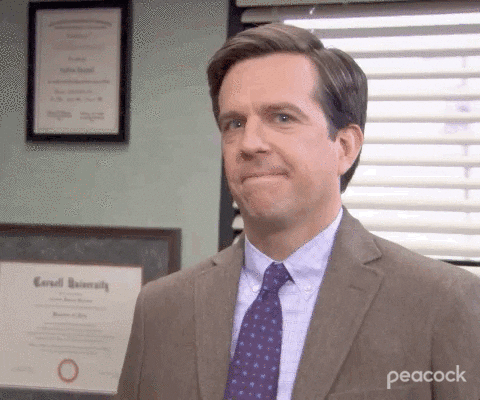
The first step to getting over feeling uncomfortable on camera is understanding “WHY” it scares you.
Having your voice, image and actions recorded can put a spotlight on the things you are self-conscious about… and might highlight nervous ticks you didn’t know you had.
Knowing what part of being on video freaks you out will help you focus on steps to feel more confident in that area… and ultimately more comfortable on camera.
-
Know what you want to say
Once you’ve sorted your fear(s).. being on camera is going to be a lot easier and more comfortable when you know what you want to say.
Set aside time to determine your message, plan your main talking points, and make some notes.
Once you know what you want to say, keep practicing it as that preparedness will lessen your anxiety.
Focus on knowing your message, not memorizing your line. This will help prevent you from sounding like a robot who’s reading off a piece of paper sitting right in front of it.
-
Put effort into your outfit
If you’re wondering how to be comfortable on video, think about what makes you comfortable in general.
Wearing the “right” outfit tends to make people more comfortable in various situations… and video is no different.

Wear things that you’re comfortable in and make you feel confident, and don’t forget to dress like you. Try to choose outfits that reflect your authentic self in a given situation.
Think about your audience and the purpose of your video and dress to that.
If it’s a business presentation, dress as you would if you speaking in front of a group at the office.
If it’s a one-to-one video for a colleague, then being a bit more casual might be appropriate.
The key takeaway is to dress in line with the purpose of the video.
-
Talk slowly
Maybe a bit slower than usual. Do your best not to rush, you don’t have to get everything out straight away.
Try to speak a bit slower than you normally would, and make pauses between thoughts.
Slowing down a bit while talking can also make you feel a bit calmer.
It also conveys confidence to your viewer(s) because… you won’t give off that nervous energy that – sometimes – goes together with fast-talking.
-
Be natural
What better way to be comfortable on video than allowing your human element to show through?
Being on camera doesn’t need you to be any different than you are.

Be expressive, use hand gestures… and speak like you would when speaking face-to-face with a person.
Rather than edit them out, leave the human and natural elements in your video.
It makes it easier for viewers to connect with you, and also builds a sense of relatability.
-
Stage your background
This is all about making sure your background isn’t a distraction to you (or your viewers).
Not being worried about something in the background of your video will make it a lot easier to be comfortable… and focus on your message.
-
Choose good lighting
Great lighting will make you feel and look your best on camera.
Feeling like you look great is important with being comfortable – and confident on camera.
You don’t need fancy lights to get good lighting, as natural light is a great source of lighting.
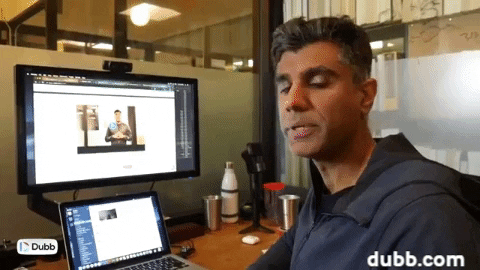
Figure out the best time you get sunlight in your area… set up your camera in front of your video, adjust your exposure (if you need to), and begin recording your message.
It’s all about making use of what you have to its fullest capacity.
-
Look directly into the camera
Capturing yourself at a great angle is one good tip for being comfortable on camera.
Most people look best on camera when the camera is positioned either at or slightly above their eye line.
Feeling confident with the way you look on camera can calm your nerves.
Try to figure out what camera angle works best and is flattering for your face… and always try to prop your camera at that level.

Once you figure out your best angle, always look into the camera lens while shooting. This conveys a sense of eye contact with the viewer and puts it that you’re in fact speaking to them directly.
Looking directly into the camera can feel awkward at first… but imagine that there is someone watching at the other end, and it will make you feel a bit more comfortable.
-
Don’t worry about mistakes
Making a mistake is one of the biggest things people worry about when recording a video. This will only make you tense and harder to feel comfortable on camera.
Small mistakes like stumbling over a word or two are not the end of the world. If anything, it makes your video conversational and natural.
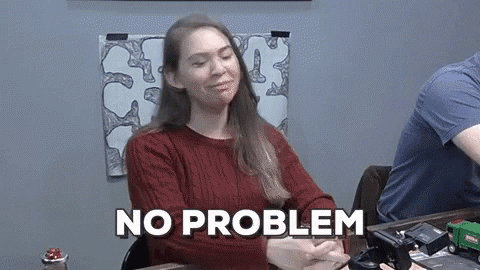
If it’s a really big mistake like skipping an entire line or losing your train of thought, don’t worry… you can always start over.
You’re allowed to make mistakes, it’s not as dire as it may seem sometimes.
-
Keep practicing — even when you don’t feel like it
You know the saying — “Practice makes perfect”. Set your camera up, get your lighting right, and start recording.
A great way to practice your on-camera skills is by choosing a test audience you know (it could be your close friends or family member)… and making videos for them.
With practicing, try doing it as many times as it takes to start feeling a bit less scary.
You can practice with a script, or have a conversation with yourself on camera (the point is to just talk).
Watch your recording with a kind eye and look for things to improve upon… such as body language, and expression.
And when you eventually put out your first video to your actual audience, don’t stop making videos.
In the end, learning how to feel comfortable on camera is a continuous process. Try to not overthink it and just keep doing it until it doesn’t feel weird.
CONCLUSION
Personality doesn’t always shine through text.
When you receive a video message, due to the sender’s tone of voice and body language… you get a better sense of who the sender is.
Video messaging is just like any other communication channel. If you want to feel comfortable on camera, you have to keep practicing. It may feel uncomfortable at first, but it gets better with time.
At the end of the day, just have fun! Everybody has something to share, so go spread your message.
Visit www.dubb.com to get started with video today.

